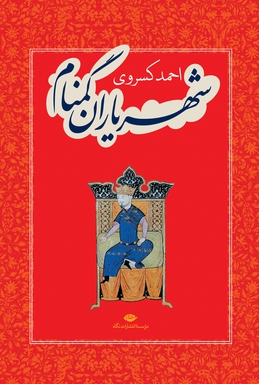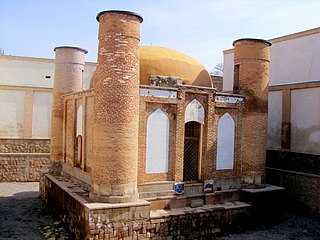
Arran, also known as Aran, was a geographical name used in ancient and medieval times to signify a historically-Iranian region which lay within the triangle of land, lowland in the east and mountainous in the west, formed by the junction of the Kura and Aras rivers, including the highland and lowland Karabakh, Mil plain and parts of the Mughan plain. In pre-Islamic times, it corresponded roughly to the territory of the modern-day Republic of Azerbaijan. The term is the Middle Persian equivalent to the Greco-Roman Albania. It was known as Aghvania, Alvan-k in Armenian, and Al-ran in Arabic.
Ibn Miskawayh, full name Abū ʿAlī Aḥmad ibn Muḥammad ibn Yaʿqūb Miskawayh al-Rāzī was a Persian chancery official of the Buyid era, and philosopher and historian from Parandak, Iran. As a Neoplatonist, his influence on Islamic philosophy is primarily in the area of ethics. He was the author of the first major Islamic work on philosophical ethics entitled the Refinement of Character, focusing on practical ethics, conduct, and the refinement of character. He separated personal ethics from the public realm, and contrasted the liberating nature of reason with the deception and temptation of nature. Miskawayh was a prominent figure in the intellectual and cultural life of his time.

The Shaddadids were a Kurdish Sunni Muslim dynasty. who ruled in various parts of Armenia and Arran from 951 to 1199 AD. They were established in Dvin. Through their long tenure in Armenia, they often intermarried with the Bagratuni royal family of Armenia.

Qatran Tabrizi was a Persian writer, who is considered to have been one of the leading poets in 11th-century Iran. A native of the northwestern region of Azarbaijan, he spent all of his life there as well as in the neighbouring region of Transcaucasia, mainly serving as a court poet under the local dynasties of the Rawadids and Shaddadids.

The history of Azerbaijan is understood as the history of the region now forming the Republic of Azerbaijan. Topographically, the land is contained by the southern slopes of the Caucasus Mountains in the north, the Caspian Sea in the east, and the Armenian Highlands in the west. In the south, its natural boundaries are less distinct, and here the country merges with the Iranian Plateau.

Shams al-Din Ildeniz, Eldigüz or Shamseddin Eldeniz was an atabeg of the Seljuq empire and founder of the dynasty of Eldiguzids, atabegs of Azerbaijan, which held sway over Armenia, Iranian Azerbaijan, and most of northwestern Persia from the second half of the 12th century to the early decades of the 13th.

Rawwadid, Ravvadid, or Banū Rawwād (955–1071) was a Sunni Muslim Kurdish dynasty, centered in the northwestern region of Adharbayjan (Azerbaijan) between the late 8th and early 13th centuries.

The Sallarid dynasty, was a Muslim dynasty of Daylami origin, which ruled in Tarom, Samiran, Daylam, Gilan and subsequently Azerbaijan, Arran, and some districts in Eastern Armenia in the 2nd half of the 10th century. They constitute part of the period in history that has been named the Iranian Intermezzo, a period that saw the rise of native Iranian dynasties during the 9th to the 11th centuries.
Lashkari ibn Muhammad ibn Shaddad was a Kurdish ruler, the son of Muhammad ibn Shaddad who succeeded his father to the throne of the Shaddadids in 971. Along with his brothers, he captured Ganja from the Sallarids in 971, coming into control of the region of Arran. After his death in 978, he was succeeded by his brother Marzuban ibn Muhammad.
Abu'l-Fath Musa succeeded his father al-Fadhl ibn Muhammad to the throne of the Shaddadids in 1031, reigning until his murder by his son and successor Lashkari in 1034.
Anushirvan ibn Lashkari was the son and successor of Lashkari ibn Musa and briefly the seventh emir of the Shaddadids at Ganja in 1049.

Abu'l-Aswar or Abu'l-Asvar Shavur ibn Fadl ibn Muhammad ibn Shaddad was a member of the Shaddadid dynasty. Between 1049 and 1067 he was the eighth Shaddadid ruler of Arran from Ganja. Prior to that, he ruled the city of Dvin from 1022 as an autonomous lord. A capable warrior, and a wise and cunning ruler, Abu'l-Aswar was engaged in several conflicts with most of his neighbours. During his rule over Dvin, he was mostly involved in the affairs of the Armenian principalities. He collaborated with the Byzantine Empire in its conquest of the last remnants of Bagratid Armenia in 1045, but when the Byzantines later turned on him, he survived three successive offensives that sought to take Ganja. In 1049, a revolt in Ganja overthrew his infant great-great-nephew, Anushirvan. The rebels invited him to take up the family's emirate, and he moved from Dvin to Ganja. Under his rule, the Shaddadid dynasty reached its zenith. He undertook successful campaigns into Georgia and Shirvan, although the limits of Shaddadid power were exposed by his failure to take over the Emirate of Tiflis and by devastating raids by the Alans. At the same time, his reign witnessed the rapid rise of the Seljuk Empire and the extension of its control over the Transcaucasian principalities. Abu'l-Aswar became a Seljuk vassal in 1054/5. Although he gained control over the former Armenian capital of Ani through Seljuk patronage in 1065, this association also paved the way for the dynasty's decline after his death in November 1067.
Fadlun ibn Fadl, or Fadl III was the last ruler of the Shaddadids of Arran from Ganja. He ruled from 1073 to 1075, until the Seljuk Sultan Malik-Shah removed him from power, giving him Astarabad. The realm was then absorbed by the Great Seljuqs, placing Sav-Tegin as governor of Ganja.
Manuchihr, Minuchihr or Manuchehr I was the eleventh Shah of Shirvan. He is considered to be first fully Persianized ruler of the dynasty. Starting from his rule, the Shirvanshahs favoured names from the pre-Islamic Iranian past and claimed descent from characters such as the Sasanian monarch Bahram V Gur.
Fadl ibn Shavur ibn Manuchihr was Shaddadid emir of Ani from c. 1125 to 1130. Fadl was the son of deposed emir Abu'l-Aswar Shavur. Fadl retook Ani from the Georgians, but promised to observe the rights of its Christian population. Fadl extended his rule to Dvin and Ganja, but failed to maintain these cities. He was murdered by his courtiers following the fall of Dvin to the Turkish emir Qurti c. 1130. His brothers, Mahmud ibn Shavur and Khushchikr, ruled briefly in quick succession until the emirate was taken over by Fadl's nephew, Fakr al-Din Shaddad b. Mahmud.
In the history of Azerbaijan, the Early Middle Ages lasted from the 3rd to the 11th century. This period in the territories of today's Azerbaijan Republic began with the incorporation of these territories into the Sasanian Persian Empire in the 3rd century AD. Feudalism took shape in Azerbaijan in the Early Middle Ages. The territories of Caucasian Albania became an arena of wars between the Byzantine Empire and the Sassanid Empire. After the Sassanid Empire was felled by the Arab Caliphate, Albania also weakened and was overthrown in 705 AD by the Abbasid Caliphate under the name of Arran. As the control of the Arab Caliphate over the Caucasus region weakened, independent states began to emerge in the territory of Azerbaijan.

The Forgotten Kings is a Chronicle account by Ahmad Kasravi. it is wrote since late 1928 to 1929, which includes documentary research on several At that time unknown and anonymous post-Islamic to pre-Seljuk Empire Iranian dynasties.
The High Middle Ages, or Classic Feudalism Period in what constitutes the present-day Republic of Azerbaijan, lasted from around the 11th century to the 15th century AD. The High Middle Ages were preceded by the Early Middle Ages and were followed by the Late Middle Ages, which ended around the 15thcentury AD. Key historical trends of the High Middle Ages include the incorporation of the territories that constitute present-day Azerbaijan into the Seljuk Empire, the establishment of the Eldiguzids, the Mongol invasions and the rule of the Ilkhanate, the invasions of Timur and the establishment of the Turkoman Kara Koyunlu and Aq Qoyunlu tribal confederations.
Muhammad ibn al-Qa'im also known as Muhammad Dhakirat was an Abbasid prince, son of Abbasid caliph Al-Qa'im. He was designated as heir apparent by his father in the mid-eleventh century CE but died before his father.

Abu Mansur Wahsudan was the penultimate Rawadid amir (ruler) of Azarbaijan from 1025 to 1058/59. He is considered the most prominent ruler of his dynasty. With the assistance of his Kurdish neighbours, he initially contained the attacks of migrating Turkmen tribes, but was eventually forced to acknowledge the authority of the Seljuk ruler Tughril in 1054. He was succeeded by his son Abu Nasr Mamlan II.










